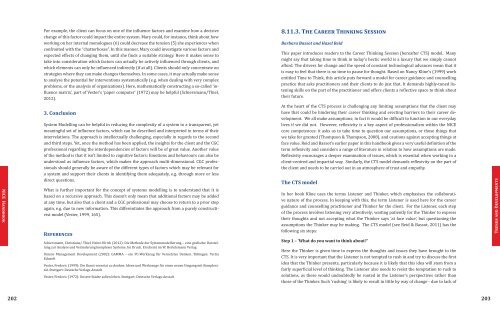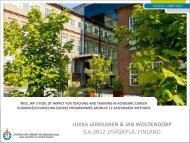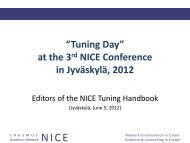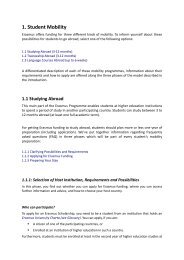NICE HANDBOOK â Academic training of Career ... - Nice-network.eu
NICE HANDBOOK â Academic training of Career ... - Nice-network.eu
NICE HANDBOOK â Academic training of Career ... - Nice-network.eu
You also want an ePaper? Increase the reach of your titles
YUMPU automatically turns print PDFs into web optimized ePapers that Google loves.
For example, the client can focus on one <strong>of</strong> the influence factors and examine how a decisivechange <strong>of</strong> this factor could impact the entire system. Mary could, for instance, think about howworking on her internal monologues (6) could decrease the tension (5) she experiences whenconfronted with the “chatterboxes”. In this manner, Mary could investigate various factors andexpected effects <strong>of</strong> changing them, until she finds a suitable strategy. Here it makes sense totake into consideration which factors can actually be actively influenced through clients, andwhich elements can only be influenced indirectly (if at all). Clients should only concentrate onstrategies where they can make changes themselves. In some cases, it may actually make senseto analyse the potential for interventions systematically (e.g. when dealing with very complexproblems, or the analysis <strong>of</strong> organizations). Here, mathematically constructing a so-called ‘influencematrix’, part <strong>of</strong> Vester’s ‘paper computer’ (1972) may be helpful (Schiersmann/Thiel,2012).8.11.3. The <strong>Career</strong> Thinking SessionBarbara Bassot and Hazel ReidThis paper introduces readers to the <strong>Career</strong> Thinking Session (hereafter CTS) model. Manymight say that taking time to think in today’s hectic world is a luxury that we simply cannotafford. The drivers for change and the speed <strong>of</strong> constant technological advances mean that itis easy to feel that there is no time to pause for thought. Based on Nancy Kline’s (1999) workentitled Time to Think, this article puts forward a model for career guidance and counsellingpractice that asks practitioners and their clients to do just that. It demands highly-tuned listeningskills on the part <strong>of</strong> the practitioner and <strong>of</strong>fers clients a reflective space to think abouttheir future.<strong>NICE</strong> Handbook3. ConclusionSystem Modelling can be helpful in reducing the complexity <strong>of</strong> a system to a transparent, yetmeaningful set <strong>of</strong> influence factors, which can be described and interpreted in terms <strong>of</strong> theirinterrelations. The approach is intellectually challenging, especially in regards to the secondand third steps. Yet, once the method has been applied, the insights for the client and the CGCpr<strong>of</strong>essional regarding the interdependencies <strong>of</strong> factors will be <strong>of</strong> great value. Another value<strong>of</strong> the method is that it isn’t limited to cognitive factors: Emotions and behaviours can also b<strong>eu</strong>nderstood as influence factors, which makes the approach multi-dimensional. CGC pr<strong>of</strong>essionalsshould generally be aware <strong>of</strong> the different types <strong>of</strong> factors which may be relevant fora system and support their clients in identifying them adequately, e.g. through more or lessdirect questions.What is further important for the concept <strong>of</strong> systems modelling is to understand that it isbased on a recursive approach. This doesn’t only mean that additional factors may be addedat any time, but also that a client and a CGC pr<strong>of</strong>essional may choose to return to a prior stepagain, e.g. due to new information. This differentiates the approach from a purely constructivistmodel (Vester, 1999, 165).ReferencesSchiersmann, Christiane/ Thiel, Heinz-Ulrich (2012): Die Methode der Systemmodellierung – eine grafische Darstellungzur Analyse und Veränderung komplexer Systeme. Im Druck. Erscheint im W. Bertelsmann VerlagUnicon Management Development (2002): GAMMA – ein PC-Werkz<strong>eu</strong>g für Vernetztes Denken. Tübingen: TertiaEdus<strong>of</strong>tVester, Frederic (1999): Die Kunst vernetzt zu denken. Ideen und Werkz<strong>eu</strong>ge für einen n<strong>eu</strong>en Umgang mit Komplexität.Stuttgart: D<strong>eu</strong>tsche Verlags-AnstaltVester, Frederic (1972): Unsere Städte sollen leben. Stuttgart: D<strong>eu</strong>tsche Verlags-AnstaltAt the heart <strong>of</strong> the CTS process is challenging any limiting assumptions that the client mayhave that could be hindering their career thinking and erecting barriers to their career development.We all make assumptions; in fact it would be difficult to function in our everydaylives if we did not. However, reflexivity is a key aspect <strong>of</strong> pr<strong>of</strong>essionalism within the <strong>NICE</strong>core competences: it asks us to take time to question our assumptions, or those things thatwe take for granted (Thompson & Thompson, 2008), and cautions against accepting things atface value. Reid and Bassot’s earlier paper in this handbook gives a very useful definition <strong>of</strong> theterm reflexivity and considers a range <strong>of</strong> literature in relation to how assumptions are made.Reflexivity encourages a deeper examination <strong>of</strong> issues, which is essential when working in aclient-centred and impartial way. Similarly, the CTS model demands reflexivity on the part <strong>of</strong>the client and needs to be carried out in an atmosphere <strong>of</strong> trust and empathy.The CTS modelIn her book Kline uses the terms Listener and Thinker, which emphasises the collaborativenature <strong>of</strong> the process. In keeping with this, the term Listener is used here for the careerguidance and counselling practitioner and Thinker for the client. For the Listener, each step<strong>of</strong> the process involves listening very attentively; waiting patiently for the Thinker to expresstheir thoughts and not accepting what the Thinker says ‘at face value’, but questioning theassumptions the Thinker may be making. The CTS model (see Reid & Bassot, 2011) has thefollowing six steps:Step 1 – ‘What do you want to think about?’Here the Thinker is given time to express the thoughts and issues they have brought to theCTS. It is very important that the Listener is not tempted to rush in and try to discuss the firstidea that the Thinker presents, particularly because it is likely that this idea will stem from afairly superficial level <strong>of</strong> thinking. The Listener also needs to resist the temptation to rush tosolutions, as these would undoubtedly be rooted in the Listener’s perspectives rather thanthose <strong>of</strong> the Thinker. Such ‘rushing’ is likely to result in little by way <strong>of</strong> change - due to lack <strong>of</strong>Trends and Developments202 203






